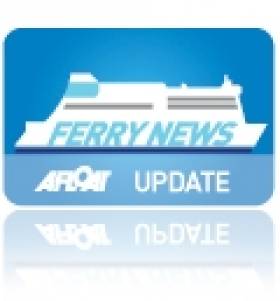Displaying items by tag: New LPG CorkRoscoff cruiseferry
Brittany Ferries Order Giant LNG Powered Cruiseferry
#NewFerry - Brittany Ferries has announced an order for its largest ever cruiseferry, a 52,000 tonnes giant powered by liquefied natural gas (LNG) and entering service in 2017 on Cork-Roscoff and UK-Spain routes.
The 12 deck cruiseferry with a capacity for 2,474-passengers, 675 cabins and 800 vehicles will be the first such ferry to serve in Irish and UK waters and one of the biggest vessels of its type in the world.
Brittany Ferries' current flagship, Pont-Aven is to move to the Portsmouth-St. Malo route when the 210-metre long newbuild is expected to enter service in late Spring of 2017.
She is to be built by STX France shipyard in St. Nazaire. For the last two years Brittany Ferries and the shipyard have been co-operating for two years on a study regarding the feasibility of powering a cruise-ferry by LNG.
The newbuild will also be the cleanest, most environmentally-friendly ship to operate in UK waters because LNG emits about 25 per cent less carbon dioxide during combustion than marine fuel oil and burns with no smoke. It is entirely free of sulphur and is very low in nitrogen oxide emissions.
Operating on the longer routes between UK and Spain, she will have many of Pont-Aven's features, such as an indoor swimming pool, two cinemas, restaurants, pet kennels, and so on. In addition, she will have 30 pet-friendly cabins which have proved so popular on the operatorsother ship to Spain, Cap Finistère, as well as a quiet reading lounge, an observation area, and a sophisticated spa treatment room with panoramic views. The latest technology will be applied and free Wi-Fi will be available in every cabin and throughout the ship.
Families will be well provided for, with two children's play areas as well as a teenager zone. As you would expect on any cruise ship, entertainment features prominently and there will be 3 stylish bars and a high-tech stage area.
Brittany Ferries already has an enviable reputation for the quality of its ships, as well as its service and cuisine, but this will be further enhanced by some of the luxury features of this new cruise-ferry. For example, each of the Commodore Suites will have its own balcony.
Mike Bevens, Group Commercial Director comments: "This represents a huge investment which will benefit not simply our customers but the environment as well. Unlike other forms of transport, such as aircraft or trains, every one of our ships is different, each possessing its own unique character."
"This addition to our fleet will be no exception, but will incorporate all the best features of our other vessels so as to provide our customers with a truly exceptional experience. No other ferry in the UK will come close to offering this new ship's range of facilities and its launch will mark the beginning of a new era in ferry travel."























